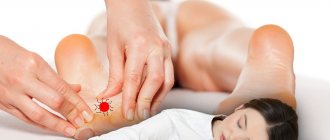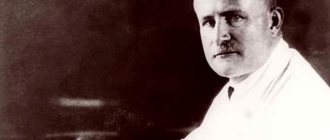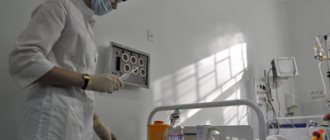Stress accumulated during the working day manifests itself physically in the form of illnesses and ailments. You come home after work and your to-do list never ends. Very little time for self-care. But what if you set aside a little time every day for health and well-being? Sometimes it's important to focus on yourself. This will significantly reduce stress, prevent disease and slow down the aging process.
Try these yoga poses - they are simple, but after regular practice, the results will pleasantly surprise you. Stress levels will decrease, body flexibility will improve, and along with flexibility will come a feeling of well-being and inner peace.
Mountain Pose (Tadasana)
This pose is one of the simplest, but it is not immediately possible to perform it perfectly.
Technique: stand straight, feet firmly on the floor, spread your toes wider. Legs, feet, ankles are connected. Tighten your buttocks so that your pelvis is over your feet. Tuck your stomach in and roll your shoulders back and down. Hands are lowered down with palms facing out. Close your eyes and stay in the pose for 5 to 10 breaths.
Forward Bend (Uttanasana)
This pose causes a rush of blood to the spine and head.
Technique: From a standing position, fold forward and reach your hands to your feet or ankles, or, if you find it difficult, to your hips or knees.
Relax. Allow your lower back to lengthen and the crown of your head to hang towards the floor. The neck and shoulders are completely relaxed. Breathe deeply, and with each exhalation, pull your stomach towards your knees. Stay in the pose for 5 to 10 deep breaths.
Physiological effects of yoga on body and mind
One of the most common misconceptions about yoga is that yoga is just another form of exercise. In fact, the benefits of yoga extend beyond the physical body. Thanks to modern technology, we can see how regular practice affects the brain by increasing gray matter density. How does this happen?
Our brain is mainly made up of two types of tissue: 60% white matter and 40% gray matter. Both play an important role in cognitive performance, however, each type of tissue has different functions.
Gray matter is made up of brain cells, or neurons. It is responsible for learning abilities, memory, vision, hearing, smell and touch. Affects muscle control and self-awareness. White matter is a network of connections that connect parts of the brain together, allowing different areas to send and receive signals.
In other words, white matter allows the brain to coordinate thoughts and movements. Both gray and white matter complement each other, allowing us to think, coordinate movements, and interpret the world around us.
Studies based on structural brain scans have shown that general intelligence and the quality of a person's mental performance is associated with the volume of gray matter. Yoga, which involves consistent practice of body control, breathing and concentration, leads to increased gray matter density and activation in the hippocampus and prefrontal cortex.
Yoga for relaxation and stress relief works by slowing down certain parts of the brain during the session to allow for rest.
This function helps relieve stress, which is localized in two main areas of the brain - the frontal and parietal.
When you feel stressed or anxious, your body produces stress hormones cortisol and adrenaline, which increase your heart rate and blood pressure. Yoga helps reduce stress hormones.
Even 15 minutes of daily practice brings tangible benefits and can prevent serious conditions such as depression and heart disease.
Pigeon Pose (Eka pada rajakapotasana)
The pose is a great stretch for the hip joints, and is perfect for those who spend all day sitting at a desk or driving for several hours. The front of the thigh, back and hip extensors are stretched. If your back is not strong enough to stay in the position for more than a breath or two, don't be discouraged. Practice, and over time it will become easier for you to remain in this position.
Technique: Start sitting with one knee on the mat at a 90-degree angle. The second leg is straight and remains behind. If necessary, use a block under the hips. This will relieve some of the pressure and make balancing easier until flexibility improves. Mentally stretch from your lower back to the ceiling. Hold the pose for 5 to 10 breaths on each side and gradually increase the duration. Repeat on both sides.
You can't relax when you're tense
What we used to call a “tense” or “relaxed” state is the result of the work of the autonomic nervous system. It is called vegetative (from the Latin “vegetabilis” - plant) because it regulates “plant”, biological processes in the body that cannot be controlled by the human will: blood pressure, digestion, thermoregulation.
The autonomic nervous system is a sensitive mechanism whose task is to successfully adapt the body to the constantly changing external environment. So, when the air temperature drops, you may begin to shiver to prevent hypothermia, when your blood glucose level drops, you may feel hungry, and when you see your neighbor’s shaggy dog running towards you, a powerful surge of adrenaline will allow you to run ten times faster than when passing boring standards in school physical education classes.
Reclining Pigeon Pose (Eka Pada Rajakapotasana)
Deeply bending pigeon pose requires less effort and is more relaxing. Stay in it longer and breathe. The asana releases stress and tension in the hips and increases flexibility.
Technique: Start in the same position as pigeon pose and slowly lower yourself onto your palms or forearms onto the floor. If it becomes easy, fold your hands on top of each other and rest your forehead on your hands. Stay in this position for 5 to 10 breaths. Repeat on both sides.
How does yoga help with fatigue?
Since ancient times, the ability of yogic mental practices to restore a person’s energy balance has been known. Despite the fact that physical exercise may seem like an additional burden to a tired person, a gentle set of asanas is a natural energy recharge and an effective cure for fatigue. Yoga for relaxation and relieving fatigue provides an opportunity not only to fully relax and renew your energy supply, but also to improve mental health. Let's look at a number of asanas that help eliminate all manifestations of stress and exhaustion.
Cobra pose (bhunjangasana)
This pose strengthens the back, opens the shoulders, chest, and strengthens the muscles along the spine.
Technique: from a prone position on your stomach, both palms under your shoulders, fingers spread wide, pelvis pressed against the mat, push off the floor with your hands and lift your chest up. Pull your shoulders away from your ears, lengthening your neck. Look up a little. Take a few breaths and slowly lower yourself to the starting position.
Cow Head Pose (Gomukhasana)
Crossing your hips is not as easy as it seems. For those who find this pose difficult, use a pillow or rolled up blanket and place it under your hips.
Technique: Place your left leg on top of your right, cross your knees, and sit between your legs. You need to sit with your back straight. Place your right hand back, behind your head, and your left hand back, below, and clasp your hands together. Hold the pose for up to 10 exhalations on each side.
↑ Scientific confirmation
Many years ago, scientists established the relationship between the body and the psyche. Even in ancient times, people tried to diagnose character traits based on external signs. But, unfortunately, in modern psychology this problem began to be studied in detail only in the middle of the last century. According to the results of scientific research, experts have found that the psyche directly affects a person’s physical condition. This occurs through constitutional characteristics, muscle tissue tightening, and a decrease in joint mobility.
{banner_banner1}
From this we can conclude that the opposite hypothesis also has a right to exist. The physical state of the body can change the human psyche.
Wide Leg Forward Bend (Prasarita Padottanasana)
Sometimes simply bending forward can be challenging for those with tight hips and hamstrings.
Technique: Spread your legs as wide as you can.
Place your palms between your legs and slowly step them forward until your elbows touch the floor. Breathe deeply, consciously relaxing tense areas. Hold the pose for 5 to 10 breaths and gradually increase the time you stay in the pose. The more you hold this pose, the faster you will see progress.
King of the Fishes Pose (Ardha Matsyendrasana)
To completely relax and relieve stress before completing your session, include a seated twist in your practice. It stretches the muscles of the lower back, hips, buttocks and spine.
Technique: sit on the floor, place both legs in front of you, bend your left leg at the knee and cross it over your right, so that your foot is on the floor near your right thigh.
Then turn your body to the left. Inhale and join your palms in namaste. Hold the pose for three to five breaths. Repeat on the other side.
Chandra bhedana pranayama
To deal with stress, you can practice Chandra bhedana pranayama. This is breathing through the left nostril, which fills with energy the left, lunar, channel, which is responsible for our calm and balance.
Sit in a comfortable cross-legged position. Place your left hand on your knee. Place the fingers of your right hand in nasikagra mudra. Inhale through your left nostril and exhale through your right. At first, inhalation and exhalation may be equal. The exhalation can then be lengthened for greater impact on the parasympathetic system.
Contented Child's Pose (Ananda Balasana)
This pose completely relaxes the back and pelvis.
Technique: lie on your back, pull your knees to your chest, grab yourself by your big toes, while keeping your pelvis on the mat. Try to pull your knees towards your armpits. Feel the stretch in your groin area. This pose perfectly relaxes, relieves stress and tension. Hold for 5 to 10 breaths.
Causes of stress
Stress is usually a reaction to mental or emotional pressure. This often feels like a loss of control over the situation. What can trigger a stressful situation?
Work (conflicts, lack of work, retirement); family (difficulties in relationships, divorce, caring for a seriously ill relative); financial problems, health status (injuries, illnesses); existential problems (lack of meaning in life, loss of life guidelines).
Even such significant events as buying real estate, a wedding, or the birth of a child, which seem to carry a positive charge, can cause stress.
Lying Twist Pose (Supta Matsyendrasana)
The purpose of this pose is to release tension in the spine.
Technique: lying on your back, with a deep breath, lift your knee to your chest and move it in the opposite direction. (if left, then to the right, if right, then to the left). Do not lift your shoulders off the floor, keep your hands free. Release any tension, feel your body open and free. Repeat on the other side.
What you need to know about stress?
- Everyone is subject to stress.
Everyone experiences stressful situations from time to time. Stress can be short-term or can last for a long time. Some people cope with stress more quickly, while others suffer from prolonged stress. - Long-term stress can be harmful to your health.
Coping with chronic stress is a difficult task because the body does not receive a clear signal to return to normal functioning. Thus, chronic stress can disrupt the immune, digestive, cardiovascular and reproductive systems. - Stress can be managed.
By practicing asanas to calm the nervous system, you can reduce the risk of negative health effects. Reading spiritual literature will help you more calmly and adequately perceive what is happening around you.
Knee press
The pose stretches the back and relieves tension.
Technique: Lie on your back with your arms and legs extended. As you inhale, pull your knees to your chest and hug them with your arms. Keep your back straight and rock gently from side to side and back and forth. The chin is pressed towards the chest to align the neck. Exhale and gently lower your feet to the floor.
Unity and struggle of opposites
The balance of autonomic nervous tone is maintained by two opposing systems - the sympathetic (responsible for activity) and the parasympathetic (providing for the restoration of strength). Just as in nature, day gives way to night, and cold to warmth, hormones alternately turn on one or the other system, allowing the body to either waste or accumulate energy, maintaining harmony.
The optimal interaction between the autonomic nervous system and the environment, unfortunately, is just a paragraph from a biology textbook. Life in its diverse and unpredictable manifestations often causes the ANS to malfunction: before bed, stubborn sympathetic tone continues to force you to waste energy on thinking about the events of the past day and unnecessary muscle tension, or, conversely, the onset of lethargy and fatigue prevents you from concentrating on an important work task.
Lying Butterfly Pose
The asana stretches the inner thighs and groin. Increases blood flow into the pelvis.
Technique: Lie on your back with your legs and arms straight.
Bend your knees and spread them apart. Feet together. Place your hands on your knees, palms up. Adjust your spine by lengthening it while maintaining the natural curve of your lower back. Close your eyes. Breathe naturally. Stay in the pose for 5 to 10 minutes. To exit the pose, bring your knees together and place your feet on the floor.
↑ Side effect of practice
In the early stages of training, side effects may appear. This is caused by the fact that when performing exercises, the nerve endings touch the soft tissues and the skin itself. This circumstance occurs due to the fact that internal channels receive a large
amount of energy. Therefore, irritation, rashes, bumps, and swelling of soft tissues may appear on the skin.
If you have such symptoms, you should consult a doctor to rule out serious consequences. However, in practice it is believed that negative energy comes out through these wounds and the body is cleansed. If you continue to practice yoga, the illness will quickly pass, and small wounds will heal.
If there are no results for a long time, then you need to undergo a full examination at a medical center. This may indicate that the person has a severe blockage of the chakras, which implies the presence of a serious illness that occurs without visible symptoms. This can be attributed to the advantages of the technique, since it is very important, for quick and effective treatment, to make a diagnosis in the early stages of the disease.
Legs up against the wall (Viparita Karani)
The pose stretches the back of the legs and calms the mind. Like all inverted poses, this asana has a rejuvenating effect. It also reduces anxiety, headaches, insomnia and depression.
Technique: Place a cushion or pillow against the wall. Then carefully lift your legs up onto the wall. Shoulders and head on the floor. Hold the pose for 5 to 10 minutes.
From courses in psychophysiology and anatomy (I previously thought that they would not be useful to me at all), I know that our nervous system is divided into sympathetic and parasympathetic. Most of us have a more active sympathetic nervous system , which increases heart rate, blood pressure, cortisol levels, and muscle tension, while the parasympathetic nervous system decreases heart rate, blood pressure, cortisol and blood sugar levels, and muscle tension.
The sympathetic system usually works hard for us, since its main functions include:
- Regulation of resource consumption.
- Mobilization of forces in emergency situations.
- Control of emotions.
And the parasympathetic system is responsible for:
- Accumulation of strength and resources.
- Recuperation, rest, relaxation.
That is, it is clear that if the sympathetic system is too activated, then we are tired, do not get enough sleep, etc. And if the parasympathetic system predominates, we are lethargic and apathetic...
And for our beauty, we need both systems to work perfectly and harmoniously; rather, the balance of both systems is very important.
And just like with hormonal balance, relaxation and improved sleep, we can benefit from the centuries-old experience of Yoga! For a stronger effect, I suggest using Yin Yoga techniques, that is, instead of blocks and “bricks”, take blankets and bolsters.
1. Supta Baddha Konasana. My favorite calming solution for insomnia or menstruation is the wonderful reclining butterfly pose.
It calms the mind very well and helps to practice deep breathing. As your breathing begins to deepen, try extending your exhalation after inhalations and notice the calming effect.
You can try reducing sensory stimulation (light, sound, etc.) by turning off the lights and closing your eyes. The sleep bandage is ideal for calming the nervous system while lying down.
Note: You can do this even if you don't do yoga! Although in this case I advise you to do stretching, the effect of stretching on our hormonal system is absolutely amazing!
Additional instructions:
The feet are pressed as close to the perineum as possible. Hips relaxed. The chest is expanded. The tailbone is directed towards the feet so that the lower back does not bend too much upward. The chin is slightly lowered, the neck is straightened.
With each inhalation, try to calm down, and with each exhalation, relax even more. Direct the relaxation to the pelvic area.
WRONG
Do not lift your lower back and chin up.
2. Supported bridge pose.
This pose calms the nervous system.
The connecting nerve cells of the parasympathetic nervous system are located in the brain stem and in the sacral part of the spinal cord . Light pressure on the sacrum stimulates the rest of the body.
3. Inverted pose.
From the previous pose, simply extend your legs up; for greater relaxation, you can lean them against the wall.
The heart is higher than the head, calming the nervous system, but the legs are now higher than the heart and help eliminate heavy legs by lowering the heart rate and regulating blood pressure.
4. Seated butterfly pose.
This same asana was taught to us in yoga for hormones, so it is doubly useful :). It has a deeply calming effect on the body and mind.
If you feel that this is possible, place a block under your forehead, this way you will relax your jaw and neck muscles, the pose will slightly stimulate the hypothalamus and pituitary gland , thus balancing your nervous system. Sit on a blanket or bolster to achieve greater relaxation.
5. Child's pose.
Completely releases all muscle tension and is one of the best ways to calm the nervous system.
Try the restorative child's pose: lower your entire weight onto the bolster and close your eyes. You can even turn down the lights to avoid any sensory irritation.
Child's pose with knees wide apart relaxes the pelvic floor muscles.
All these poses are extremely simple, and there are a lot of benefits from them.
Try it and please share how it went, what effect this yoga had on the nervous system.
I have now already signed up for a small Yoga class for the adrenal glands - balancing cortisol and the nervous system. He will be presented in the course “Anti-stress in the big city”!
Beauty and Radiance to everyone!
Thanks: https://www.doyouyoga.com/5-yoga-poses-to-balance-your-nervous-system-78508/











